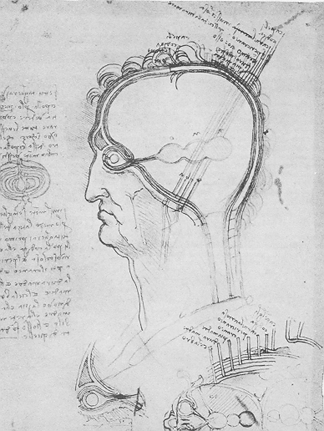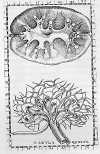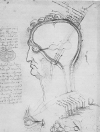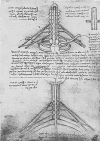
A HISTORY OF THE NERVOUS SYSTEM

"By means of nerves, the pathways of the senses are distributed like the roots and fibers of a tree." --Alessandro Benedetti, 1497
Nerves proved to be a fairly difficult part of the body to categorize. The origins of the word "nerve" -- initially a Greek word meaning tendon or sinew -- suggests a certain confusion between connective tissues and other, more subtle types of physical connections within the body. As late as the twelfth century, the Jewish philosopher Moses Maimonides observed: "One who is not knowledgeable in anatomy may mistake ligaments, tendons and chords for nerves." Nonetheless, ancient medical practitioners did understand that nerves served roughly two functions: movement and sensation. The question was how they operated and under the direction of which principal organ.
In the fourth century B. C., the Greek philosopher Aristotle believed firmly that the nerves were controlled by and originated in the heart because it was, in his interpretation, the first organ of the body and the seat of all motion and sensation. Not surprisingly, he was misled by his confusion between ligaments and nerves in drawing this conclusion. Six centuries later, the Roman physician Galen contradicted him, disparaging those "who know nothing of what is to be seen in dissection." Instead he concluded that the brain was the most important organ of the body, with the nerves emanating from it:
"I have shown in my book On the Teachings of Hippocrates and Plato that the source of the nerves, of all sensation, and of voluntary motion is the encephalon [the brain] and that the source of the arteries and of the innate heat is the heart."
Galen saw the spinal cord as an extension of the
brain which carried sensation to the limbs. He believed
th at the nerves controlled the actions of muscles
in the limbs, and that the two principal functions of the nervous system, sensation and motion, were governed
by two different types of nerves: respectively soft and hard. He
further insisted on a curious anatomical feature of the nerves, imagining them
to be hollow tubes. Quite logically, he reasoned that this must be so in
order for the animal spiritus, the body's principal source of vitality in
his system, to circulate throughout the body. As the Renaissance
illustration here indicates, the investigation of the nerves after Galen also
became an inquiry into the effect of the brain on the body.
at the nerves controlled the actions of muscles
in the limbs, and that the two principal functions of the nervous system, sensation and motion, were governed
by two different types of nerves: respectively soft and hard. He
further insisted on a curious anatomical feature of the nerves, imagining them
to be hollow tubes. Quite logically, he reasoned that this must be so in
order for the animal spiritus, the body's principal source of vitality in
his system, to circulate throughout the body. As the Renaissance
illustration here indicates, the investigation of the nerves after Galen also
became an inquiry into the effect of the brain on the body.
Medieval physicians, in agreement with Galen, believed nerves were offshoots of and controlled by the brain. The Islamic medical philosopher Avicenna wrote in the early eleventh century that "Nerves are one of the 'simple members' -- homogeneous, indivisible, the 'elementary tissues' (others include the bone, cartilage, tendons, ligaments, arteries, veins, membranes, and flesh)." He offered a more precise physical description of them -- "white, soft, pliant, difficult to tear." He and his contemporaries began to describe the complex and varied arrangements of nerves throughout the body, attempting to differentiate further their functions. In the Canon of Medicine, he observed: "Dryness in the nerves is the state which follows anger." Such statements suggest that Avicenna also believed the nerves to be entangled with and responsive to the emotions, yet another sign of their strong connections to the brain.
Slightly more than a century later, Master Nicolaus offered a more precise vocabulary to express the new complexity of the nervous system, discarding the terms "soft" and "hard" for the more familiar idea of sensory and motor nerves. He considered nerves subservient members of the brain that carried out the animal spirits to all members, endowing them with sensation and motion. He further differentiated their points of origin and termination:
 "According to some authorities, all the
sensory nerves originate from the cellula phantastica, the motor from the
cellula memorialis. There are also five kinds of sensory nerves, which are
classified according to the operations of the five senses, namely, sight,
hearing, smell, taste, and touch. Two nerves arise from the cellula phantastica
and cross in the middle of the forehead, one of them passing to the pupil
of the right eye, the other to the left. Through these nerves visual spirits
are conveyed to the pupils." Leonardo da Vinci's famous image of the
human head makes these cells quite apparent in a drawing that clearly is based
on medieval theories of the body rather than actual dissection.
Many medieval anatomists devised elaborate theories of how the nerves created
emotions and sensations in different parts of the body through their attachment
to principal organs and members.
"According to some authorities, all the
sensory nerves originate from the cellula phantastica, the motor from the
cellula memorialis. There are also five kinds of sensory nerves, which are
classified according to the operations of the five senses, namely, sight,
hearing, smell, taste, and touch. Two nerves arise from the cellula phantastica
and cross in the middle of the forehead, one of them passing to the pupil
of the right eye, the other to the left. Through these nerves visual spirits
are conveyed to the pupils." Leonardo da Vinci's famous image of the
human head makes these cells quite apparent in a drawing that clearly is based
on medieval theories of the body rather than actual dissection.
Many medieval anatomists devised elaborate theories of how the nerves created
emotions and sensations in different parts of the body through their attachment
to principal organs and members.
The writings of the Renaissance physicians reflect a mixture of ancient
and medieval beliefs about the nervous system as well as new knowledge from
anatomical dissections. In 1520, Alessandro Achillini could still write,
much in the spirit of Galen, that "the nerves are light to receive the spirit and thin in order to
offer swift and easy passage to the spirit and flexible to serve the members."
Discussions of the nervous system increasingly reflected a mixture of close
reading of ancient texts and knowledge culled from dissections. In the
late fifteenth century, for example, Alessandro Be nedetti might still subscribe to the idea of spiritus,
but his physical description of the nervous system was considerably more precise
and detailed because of his examinations of cadavers. Similarly, his
contemporary Leonardo da Vinci initially relied quite heavily on the writings of
Avicenna and others in describing the nervous system and believed the heart to
be the first organ. But this did not prevent him from recognizing that the
nerves emanated from a different source: "The medulla is the source of the nerves which give voluntary motion
to the members." Leonardo grew increasingly more confident of his own
observations, ingeniously using a wax injection technique to obtain casts of the cerebral ventricles
and used frogs for physiological experiments on the nervous system. From
his studies he concluded that the spinal cord was the center of life. Look
at his drawing of the spinal cord. How is he trying to convey the
positioning of the nerves?
nedetti might still subscribe to the idea of spiritus,
but his physical description of the nervous system was considerably more precise
and detailed because of his examinations of cadavers. Similarly, his
contemporary Leonardo da Vinci initially relied quite heavily on the writings of
Avicenna and others in describing the nervous system and believed the heart to
be the first organ. But this did not prevent him from recognizing that the
nerves emanated from a different source: "The medulla is the source of the nerves which give voluntary motion
to the members." Leonardo grew increasingly more confident of his own
observations, ingeniously using a wax injection technique to obtain casts of the cerebral ventricles
and used frogs for physiological experiments on the nervous system. From
his studies he concluded that the spinal cord was the center of life. Look
at his drawing of the spinal cord. How is he trying to convey the
positioning of the nerves?
Throughout the sixteenth and early seventeenth centuries, ancient views of the nervous system existed in harmony with new findings. Vesalius, and even Descartes in his Treatise on Man (written between 1629 and 1633 and published in 1664), continued to speak of the place for animal spirits to roam throughout the body. In fact, Descartes continued to belief that the nerves were still hollow. Helkiah Crooke's Microcosmographia (1631) put it quite eloquently:
"The Nerves are nothing else but productions of the marrowy and slimy substance of the Brain, through which the Animal spirits do rather beam than are transported. And this substance is indeed more fit for irradiation then a conspicuous or open cavity, which would have made our motions and sensations more sudden, commotive, violent and disturbed, whereas now the members receiving a gentle and successive illumination are better commanded by our will and moderated by our reason."
Yet the space for animal spirits grew smaller and smaller as the anatomy and physiology of the nervous system became more elaborate. By 1653, William Harvey still might cite medieval authorities: "According to Avicenna, the nerves are like plantings of the brain, and provide ready intelligence for the organs of sensation; like the fingers of the hand; wherefore the brain neither sees or hears, yet knows all things." But he also took great pride in his century's extensive anatomical studies that had identified the optic, auditory, and olfactory nerves. And despite Descartes' insistence on the hollow nerve, the Scottish medical student John Moir record in his 1620 lecture notes: "nerves have no perceptible cavity internally, as the veins and arteries have."
Both Harvey and Descartes represent a transitional moment in which the animate powers of the nervous system were in doubt but no fully satisfactory alternative, that would explain how unseen messages were transmitted through the body, was yet in place. Harvey wrote in his Lectures on the Whole of Anatomy: "For the nerves only carry down, they do not act, move, nor are they sentient by a faculty, but are organs." Descartes offered an important revision of the nervous system as responding to "different kinds of particle motion (we should term these stimuli)" which stimulated the nerve endings, producing a series of successive motions that connected nervous fibers -- a new and much more physically precise description of the structure of the nerve -- to the brain. He concluded: "The essence of motor control is, then, the direction of animal spirits into the proper interfilamentous channels for transmission to the proper nerve."
As of 1681, a new word had appeared in English -- "neurologie" -- coined by Thomas Willis to described the study of neuroanatomy. Not until the late eighteenth century did physiologists begin to make the connection between recent work on electricity and theories of the nervous system.
QUESTIONS: WHAT DIFFERENCE DOES IT MAKE IF THE NERVE IS A HOLLOW TUBE OR A FIBER? WHY WAS THE THEORY OF ANIMAL SPIRITUS SO LONG-LIVED?
Return to History of the Body Home Page